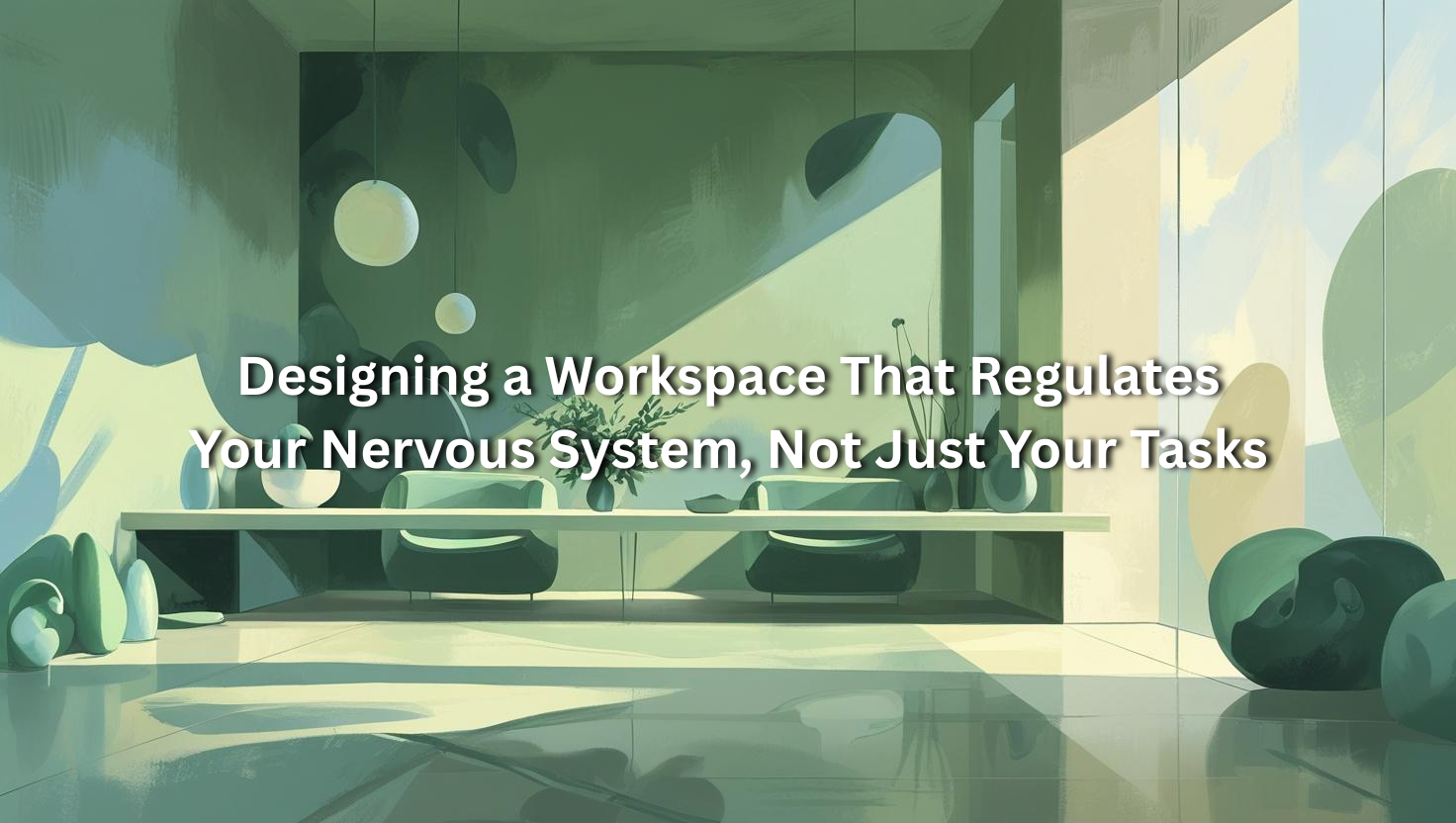We often approach productivity like a checklist—just get the right tools, organize the right tasks, and you’re good to go. But here’s what that skips over: your nervous system is in the room with you.
The desk, the lighting, the noise, the temperature, even the kind of chair you sit in—these are more than aesthetic decisions. They’re signals your body and brain respond to constantly. When your space is designed with regulation in mind, focus doesn’t have to feel forced. You’re not wrestling your own system just to stay on task.
In this article, we’re not just optimizing for output—we’re creating an environment that calms, supports, and energizes you from the inside out.

What Is a Nervous System–Friendly Workspace?
A nervous system–friendly workspace doesn’t just organize your time. It helps your body feel safe enough to think clearly.
That means:
- You’re not overstimulated or overwhelmed by clutter, brightness, or noise
- You have access to comfort cues (warmth, texture, softness, sound)
- Your brain isn’t constantly scanning for threats or distractions
- You feel anchored, grounded, and able to shift gears between work modes
This isn’t a luxury. It’s a baseline for sustainable focus.
Step 1: Start With Regulation, Not Just Organization
Traditional productivity hacks start with external systems—apps, calendars, color-coded whiteboards. But if your body is tense, overstimulated, or under-resourced, no to-do list will help.
Instead, ask yourself:
- Do I feel calm in my workspace, or am I always bracing?
- Do I have moments of grounding built into my routine?
- Can I easily shift from “on” to “off” without crashing?
The answer starts with your environmental cues—and how you respond to them.
Step 2: Use the Senses to Signal Safety
Your nervous system interprets the world through your senses. That’s why small sensory shifts can make a big difference in how focused (or frazzled) you feel. Let’s break it down.
Sight:
Visual clutter = mental clutter. Try:
- Keeping your immediate field of view clear
- Using calming or soft lighting instead of overhead fluorescents
- Setting your desktop wallpaper to something low-stimulation or nature-based
Sound:
Your brain is wired to respond to sound before logic. Use it to soothe or energize.
- White noise or brown noise for masking distraction
- Soft instrumental playlists for deep work
- Silence or natural sounds (rain, forest, waves) for regulation breaks
Touch:
Your body responds to texture and temperature more than you realize.
- Add a soft throw blanket, textured coaster, or warm mug
- Wear layers so you can adjust warmth
- Keep something tactile nearby (smooth stone, fidget ring, etc.)
Scent:
Scents can ground you instantly. Consider:
- A roll-on essential oil (lavender for calm, citrus for clarity)
- Incense or a diffuser between tasks
- Scent as a ritual to mark transitions (on/off work)
Movement + Posture:
If your chair makes you tense, your nervous system is already working overtime.
- Use lumbar support or switch to a standing desk occasionally
- Stretch or walk during transitions—even 1 minute helps
- Ground your feet on the floor or a footrest for nervous system support
Step 3: Build in Soft Transitions
Most burnout comes not from doing too much, but from never having time to come down. A regulated workspace includes intentional transition rituals.
Try:
- Playing a short reset soundscape before starting deep work
- Lighting a candle at the beginning or end of your work session
- Using an aesthetic timer to mark 25 minutes of work and 5 of recovery
- Standing up between tasks to reset your body, not just your mind
These cues help your system shift without resistance.
Step 4: Respect Your Energy Curve
Your nervous system has natural highs and lows throughout the day. If you’re forcing productivity at your lowest point, the space needs to hold you up—not push you harder.
- Morning focus? Choose bright light, energetic soundscapes, and standing tasks
- Afternoon lull? Use gentle lighting, calming music, and comfort-focused textures
- Evening wrap-up? Shift to warmer light, silence or slow sound, and reflection
Let your workspace change with your body, not fight against it.
Step 5: Make It Yours, Not Pinterest’s
Regulating your nervous system is deeply personal. Maybe you need a moodier workspace to feel safe. Maybe you thrive with maximalist surroundings. The point isn’t perfection—it’s tuning into what actually feels good to you.
Ask:
- What space made me feel most focused this week? Most at ease?
- Where do I go when I need to reset? Can I bring elements of that into my workspace?
- What sensory inputs drain me, and which ones restore me?
Your nervous system will tell you what works. You just have to listen.

Regulated People Work Better—Not Harder
When your nervous system is calm, your mind gets clearer. You make decisions faster. You stop catastrophizing every Slack ping. You don’t white-knuckle your way through tasks—you flow through them.
Designing a workspace that regulates you isn’t about being soft or indulgent. It’s about creating the internal conditions for sustainable productivity, creative thinking, and meaningful work.
Because you’re not just a task machine.
You’re a body, a mind, and a whole system.
And your environment should treat you like it.

.png)

.avif)